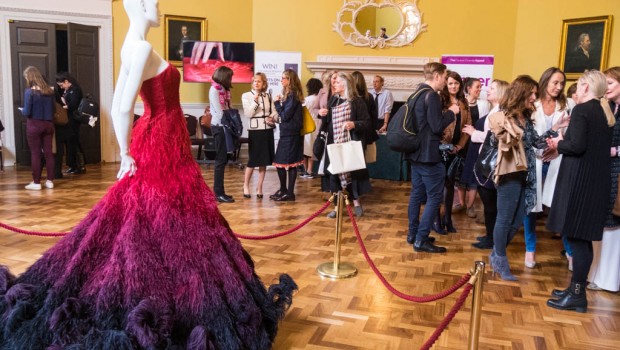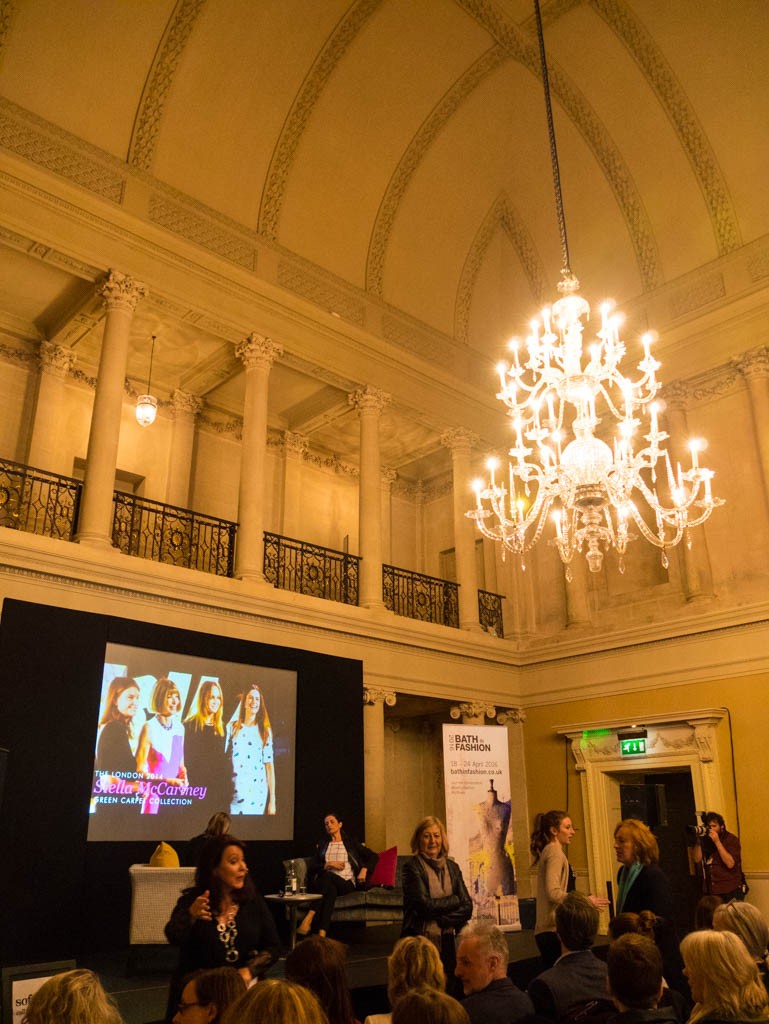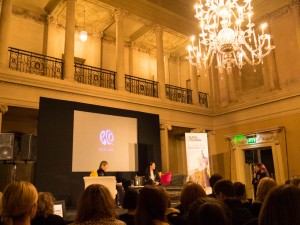If money weren’t an issue, I would have been up and down to Bath all through its Fashion Week, and despite entering every competition I could find, I did not win any tickets to the fashion shows. I did however buy a ticket to see this event with Livia Firth in conversation with fashion writer, Avril Groom. As you probably know, I make and sell clothes by recycling/repurposing/reclaiming/upcycling (insert favourite buzz-word here) unwanted fabrics with my clothing label Oshun, so sustainable fashion is something I am very interested in….
After a look around the new exhibition at the Fashion Museum (more on that later), and a little nose at the catwalk set-up in the ballroom, I queued in the Octagon with this gorgeous dress in front of me, and coincidentally ended up standing next to a lady who had been on the same park and ride bus as me! She’d been to several events that week and had been having a great time with her friend. Anyway, I’d never been in this part of the building before as it has always been hired by couples getting married on previous visits, so it was lovely to see the beautiful Georgian architecture. You really can imagine those Jane Austen evening’s out at the assembly rooms!
This talk was taking place in the tea room; and with coffee and pastries included (so said the ticket), I had expected an informal setting, perhaps with groups of people sitting round tables; but no, it was a usual conference room set-up with rows of chairs facing the stage. The massive chandeliers did give it a grand atmosphere though! Livia was introduced as founder (along with her brother) of ‘Eco-age’, a brand consultancy, helping companies become environmentally and ethically friendly. She’s an Oxfam global ambassador and began the ‘Green-carpet challenge’ (where these important fashion issues are talked about with designers and celebrities). She explained that when she was in Dhaka with Oxfam, she asked to be smuggled into a clothing factory to see what it was like and talk to the women who worked there. Livia described how hot it was, with bars at the windows to prevent anyone from opening them and an armed security guard at the door. The women worked twelve to fourteen hours a day and were allowed two loo breaks. There were no fire escapes and the workers were crammed in. She said once you’ve seen this, you can’t then pretend you haven’t, so that’s how she became actively involved in promoting sustainable fashion.
“The world is not run by naked people.”
Livia briefly talked about the fact that some people dismiss the issues, claiming that fashion is not important; it’s too trivial to worry about. Her reply is that this is nonsense; the world is not run by naked people. Fashion is important. The main theme of the talk was to try and change the way we shop. She is very against ‘fast fashion’ ie. cheap clothing that is thrown away easily. H&M is the main shop she is against, along with Zara; (though surprisingly Primark wasn’t mentioned) and these brands appeared often in the film called True Cost that she produced as well. (Review of that later!) Every other week shops like these bring in a new collection, encouraging people to keep coming in and spending their money. They give their old clothes to charity, but the charities ship them off to developing countries where they have too many of these clothes, and kills the local sewing industry.
“Chasing the cheap needle.”
The factories are forced to produce clothes at cheaper and cheaper prices, and are threatened with the business given to cheaper factories and even countries instead. Ethiopia is apparently becoming the new cheapest place to produce clothing, rather than Bangladesh.
“Who needs all this crap?”
This sentence was greeted with cheers and a round of applause from the audience when Livia was talking about the amount of clothes we buy. For the same cost as several items from a cheap clothing shop, we should instead buy one item that will last several years. If the consumer starts to invest in slow fashion, rather than fast fashion, then the lack of demand for the cheap shops will reduce the pressure on the clothing factories, leading to better pay and conditions. When Livia picks up an item of clothing in a shop she checks the quality for durability and asks herself if she’ll wear it at least thirty times. If the answer is no, then she’ll put it back. She’ll also ask herself how versatile the piece is; what does she already have to wear it with? and would she wear it when she’s sixty?
Marks and Spencer is a shop that Livia and Avril praised. They are involved in their complete supply chain and have long-term relationships with their suppliers. They only have eight to twelve collections a year and old stock is recycled into new fibres. Livia works with the shop and produces her own label with them.
“It sounds a bit brown rice and sandals.”
Joked Avril, when asking why some brands don’t like to come forward and publicly claim to be sustainable. The problem is, that as soon as they do, there’ll be an investigative journalist who deliberately goes out to find that one underage worker so that they can be disproved. Livia admitted that it is a complicated industry and companies are afraid to be attacked for not being perfect.
There were a couple of questions taken from the audience at the end and one of them was about what makes a garment sustainable, particularly when there is a large carbon footprint in any manufacture of clothes, from where the cotton is grown, to where it’s made into fabric, to where it’s made into clothing; to where it is sold in shops. Livia agreed that it is a problem, but when a business stops to actually consider their supply chain, then they can see where improvements can be made.
Someone else asked how those of us who aren’t in the know, can tell which brands we should be buying. Livia’s answer was that rather than blaming companies, we should take responsibility for our clothes ourselves; respect and look after them and buy less. This was the only bit of the talk that I found frustrating, but from the film, True Cost, I understand it’s very difficult to actually find out this information. She actually said that the more a brand goes on about how sustainable they are, then the most likely it is that they’re not.
Now I know she was referring to H&M again, and their ‘world recycling week’, but I thought this comment was a bit contradictory, considering that is exactly what her own business does, and when walking past M&S, I noticed big signs outside advertising their ethical policies.
I found the talk incredibly interesting, and Livia herself was very engaging and her passion for the subject really shone through and infected the audience. It certainly gave me a lot to think about, and no doubt I’ll be talking about this subject on this blog quite a bit from now on.
(Deviating from the point somewhat here!:) As we filed out the tea room, I asked a member of staff about the coffee and pastries that didn’t materialise. Apparently they knew nothing about it. I did buy my ticket quite a while ago, so maybe it changed, so either hardly anyone had it written on theirs, or they didn’t care; but I’d deliberately not eaten lunch in anticipation of those pastries and I have to be honest, was looking forward to them as much as the talk (I have been on a diet!) and I was starving! It turned out, the only other person to ask about
this was the same park and ride lady, so we ended up sitting with each other while we had a drink and piece of cake from the cafe. I had hot chocolate and orange and poppyseed cake, which I have to say was delicious. It was kindly put onto the Bath in Fashion account, and I’m glad there was someone else, so it wasn’t just me quibbling! This lady had a different reaction to the talk than me, and was quite angry about it actually. I think she sussed she was sitting with someone who probably didn’t agree with her, so she didn’t go into detail as to why. She mentioned the carbon footprint of clothing again, and the fact that it’s so difficult for a company to keep track of their supply chain, so how are we supposed to know who to believe? She has a point. We need the clothing industry properly regulated, so we can have a convenient list of who to buy from and who not to buy from, because at the end of the day, buying one shirt that’s going to last fifty years, is not as much fun as buying several trendy items. I always thought fashion should be fun, but at the same time, I don’t want what I wear to have been made by slave labour. I also don’t want discarded clothes clogging up landfill. I suspect that this lady simply objected to being told what she should do.
I am a hoarder anyway, and was brought up to make things last. Yesterday I was wearing the same black jumper that I used to wear over the top of my green school uniform jumper more than twenty years ago. I also hate waste, which is how Oshun clothing came about. However, I also like buying things – probably too many things, but they’re almost always second hand from ebay, so does that make it ok? There are a lot of issues involved in sustainable fashion and I will be talking about them and making some changes.
Please click that Follow me on Bloglovin button up there on the right to receive notifications of my blog posts. Articles to come soon will be a review of Livia Firth’s film, True Cost; my day in Bath during Bath in Fashion week, and how I’ll be trying to shop in future with ethics and sustainability in mind. Please leave a comment below if you have anything to say on these issues; and particularly if you can recommend brands with good policies.







siobhan
April 27, 2016Hi Helen
What a great well researched piece. I am boggled myself about how to be more ethical and purge my passion for as a stylist and shopaholic. There is nothing more cathartic than retail therapy but there is nothing more stressful than a wardrobe packed with too much. Just trying and sharing the word is our bit…I’d love to send you some questions and add your story to my blog x
Helen
May 3, 2016Thank you Siobhan,
Yes I am guilty of buying too much – it’s something I’m working on! It’s also difficult to buy ethically when you don’t know who to believe. Livia Firth is clearly against H&M, for example, but there was someone on Woman’s Hour last week discussing #WhoMadeMyClothes, saying H&M was fine! I do think it’s important to buy clothes that are going to last though, rather than just getting rid of them when they’re out of fashion or were so badly made they fell apart quickly.
Please do send me questions – it would be great to be on your blog! My e-mail address is helen@wickedfaerie.co.uk
Best wishes
Helen x